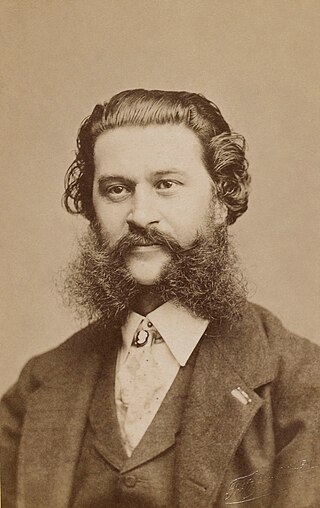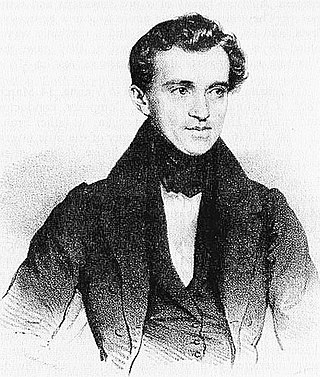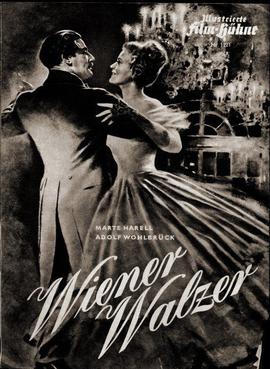
Johann Sahulka (born 25 February 1857, Deutsch-Wagram - 8 October 1927, Vienna) was an Austrian scientist and professor of electrical engineering at Vienna University of Technology. He discovered that mercury arcs act as a rectifier. [1]

Johann Sahulka (born 25 February 1857, Deutsch-Wagram - 8 October 1927, Vienna) was an Austrian scientist and professor of electrical engineering at Vienna University of Technology. He discovered that mercury arcs act as a rectifier. [1]

Johann Baptist Strauss II, also known as Johann Strauss Jr., the Younger or the Son, was an Austrian composer of light music, particularly dance music and operettas as well as a violinist. He composed over 500 waltzes, polkas, quadrilles, and other types of dance music, as well as several operettas and a ballet. In his lifetime, he was known as "The Waltz King", and was largely responsible for the popularity of the waltz in Vienna during the 19th century. Some of Johann Strauss's most famous works include "The Blue Danube", "Kaiser-Walzer", "Tales from the Vienna Woods", "Frühlingsstimmen", and the "Tritsch-Tratsch-Polka". Among his operettas, Die Fledermaus and Der Zigeunerbaron are the best known.

Johann Baptist Strauss I was an Austrian composer of the Romantic Period. He was famous for his light music, namely waltzes, polkas, and galops, which he popularized alongside Joseph Lanner, thereby setting the foundations for his sons—Johann, Josef and Eduard—to carry on his musical dynasty. He is best known for his composition of the Radetzky March.

Johann Bernhard Fischer von Erlach was an Austrian architect, sculptor, engraver, and architectural historian whose Baroque architecture profoundly influenced and shaped the tastes of the Habsburg Empire. His influential book A Plan of Civil and Historical Architecture (1721) was one of the first and most popular comparative studies of world architecture. His major works include Schönbrunn Palace, Karlskirche, and the Austrian National Library in Vienna, and Schloss Klessheim, Holy Trinity Church, and the Kollegienkirche in Salzburg.
Wiener Johann Strauss Orchester is an Austrian orchestra based in Vienna.

Johann Nepomuk Eduard Ambrosius Nestroy was a singer, actor and playwright in the popular Austrian tradition of the Biedermeier period and its immediate aftermath. He participated in the 1848 revolutions and his work reflects the new liberal spirit then spreading throughout Europe.

Josef (Joseph) August Schultes was an Austrian botanist and professor from Vienna. Together with Johann Jacob Roemer (1763–1819), he published the 16th edition of Linnaeus' Systema Vegetabilium. In 1821, he was elected a foreign member of the Royal Swedish Academy of Sciences. He was the father of Julius Hermann Schultes (1804-1840).

Leopold Joseph Franz Johann Fitzinger was an Austrian zoologist.

Johann Lukas von Hildebrandt was an Austrian baroque architect and military engineer who designed stately buildings and churches and whose work had a profound influence on the architecture of the Habsburg Empire in the eighteenth century. After studying in Rome under Carlo Fontana, he constructed fortresses for Prince Eugene of Savoy during his Italian campaigns, becoming his favorite architect. In 1700 he became court engineer in Vienna, and in 1711 was named head of the court department of building. He became court architect in 1723. His designs for palaces, estates, gardens, churches, chapels, and villas were widely imitated, and his architectural principles spread throughout central and southeast Europe. Among his more important works are Palais Schwarzenberg, St. Peter's Church, and Belvedere in Vienna, Savoy Castle in Ráckeve, Schönborn Palace in Göllersdorf, and Schloss Hof.

Deutsch-Wagram, often shortened to Wagram, is a village in the Gänserndorf District, in the state of Lower Austria, Austria. It is in the Marchfeld Basin, close to the Vienna city limits, about 15 km northeast of the city centre.

Johann Georg von Hahn was an Austrian and later Austro-Hungarian diplomat, philologist and specialist in Albanian history, language and culture.

Ignaz Bendl was a Bohemian painter, sculptor, medalist, and ivory engraver, who worked mainly in Vienna and Brno.

The Liechtenstein Museum is a private art museum in Vienna, Austria. It contains much of the art collection of its owners, the Princely Family of Liechtenstein, rulers of the principality of Liechtenstein. It includes important European works of art, forming one of the world's leading private art collections. Its highlight used to be Leonardo da Vinci's portrait of Ginevra de' Benci, which was acquired in 1967 by the National Gallery of Art in Washington, D.C.

Johann Georg Lickl, also Ligkl, Hans-Georg Lickl, Hungarian: Lickl György was an Austrian composer, organist, Kapellmeister in the main church of Pécs, and piano teacher.

Prince Franz de Paula Joachim Joseph of Liechtenstein was a son of Johann I Joseph, Prince of Liechtenstein, and his princess consort, Landgravine Josepha of Fürstenberg-Weitra. Prince Franz de Paula was a nephew of Prince Aloys I, brother of Prince Aloys II, and uncle of Princes Johann II and Franz I.

Burg Festenburg is a castle in Styria, Austria. It is located in the village of Festenburg in the municipality of St. Lorenzen am Wechsel. It was founded around 1200 by the Lords of Stubenberg as Vöstenburg. It now houses the Roman Catholic parish church of St. Katharina.

Eleonore Schwarz is an Austrian singer.
Andreas Ottensamer is an Austrian clarinettist and is one of the solo clarinettists of the Berlin Philharmonic.
Wenzel Robert von Gallenberg was an Austrian composer, particularly of ballets, which were produced in Vienna and Italy.

Vienna Waltzes is a 1951 Austrian historical musical drama film directed by Emil E. Reinert and starring Marte Harell, Anton Walbrook and Lilly Stepanek. It is also known by the alternative title of Vienna Dances.